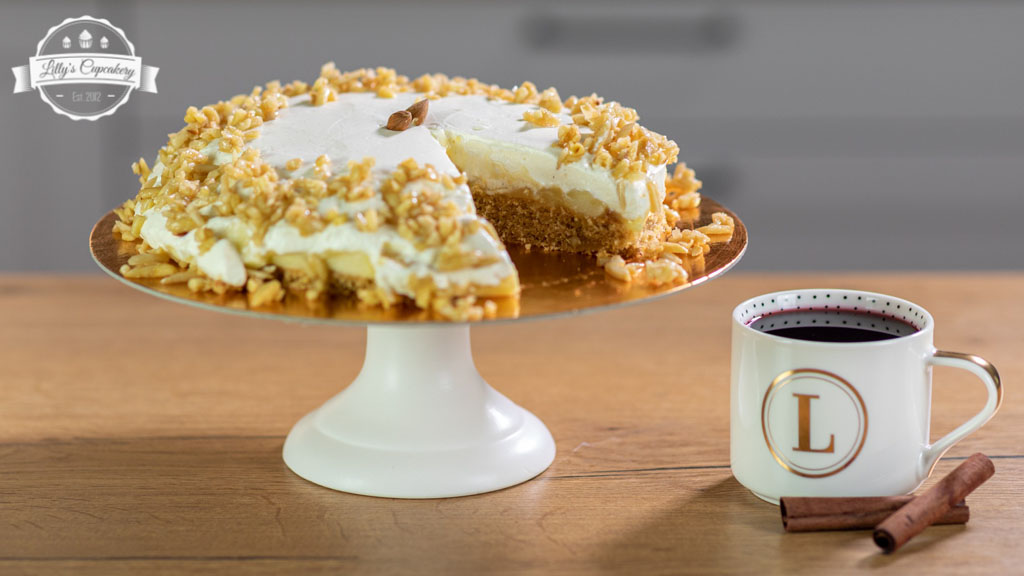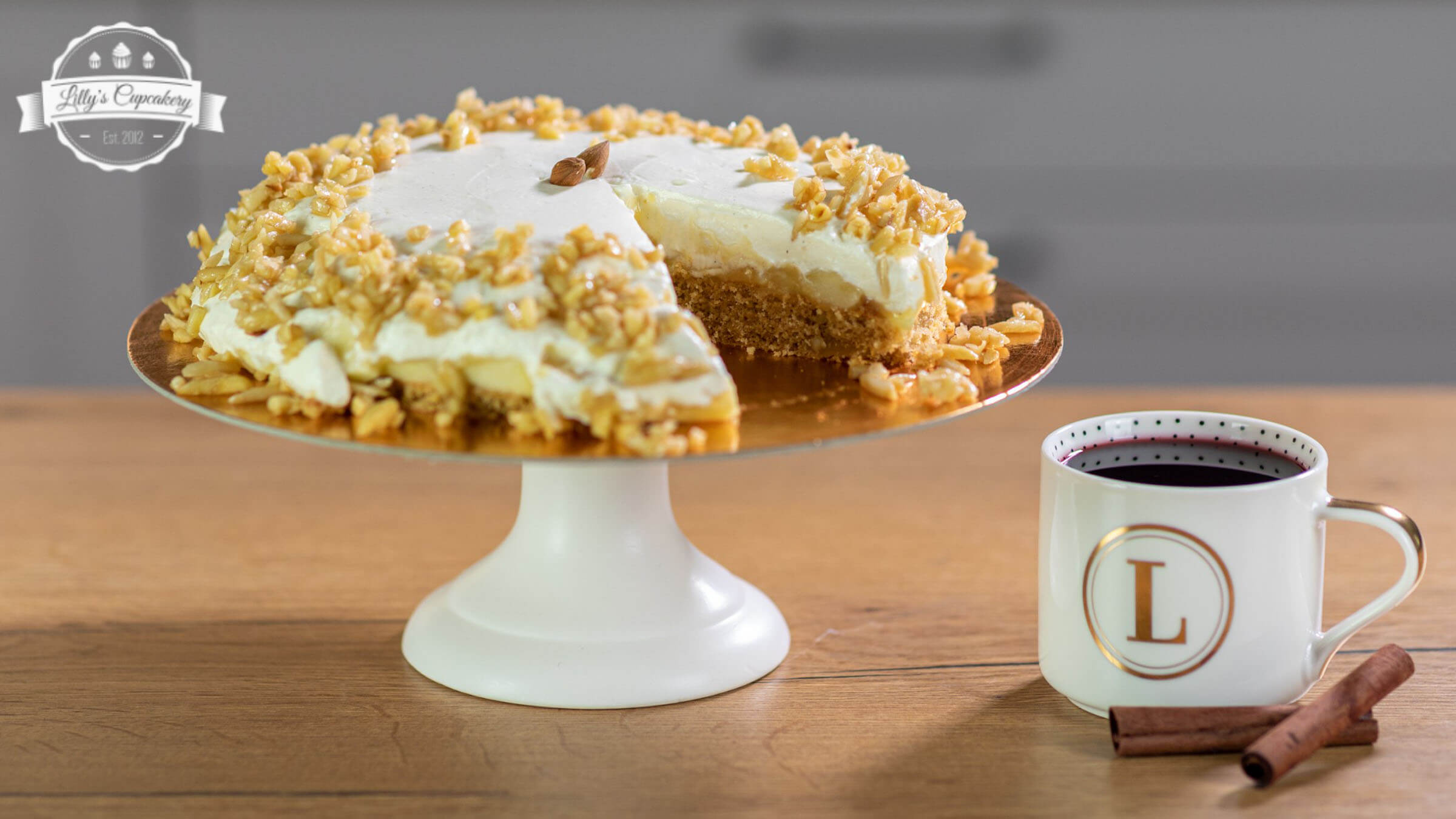Lovers of American and German baking unite on YouTube channel Lilly’s Cupcakery, run by bilingual, German-American baker Lilly Kürten. Out of her kitchen in Germany, Lilly talks you through recreating her mouth-watering recipes with bubbly enthusiasm. She reveals the secrets of a good American frosting to her German audiences, then switches to English for the next video explaining the intricacies of a German marble cake, pointing out the differences between ingredients, measurements and other, less obvious cultural distinctions.
For her Tastemakers instalment, Lilly takes a German Christmas classic – Bratäpfel (baked apples) and makes it into a wonderful holiday cake that will get a round of applause from everyone. Especially if you combine it with the other German holiday classic, Glühwein (mulled wine).
AMEX ESSENTIALS: Could you introduce yourself, for those who don’t know you?
My name is Lilly Kürten, born in 1992 to an American mother and a German father in Bad Kreuznach, Germany. I majored in American Studies and British Studies at the University of Mainz and became a freelancer at the age of 22. The middle of my week is blocked for my profession – I teach Business English at various global companies – and from Friday through Monday I bake, film, edit and upload baking videos on my YouTube channel, Lilly’s Cupcakery. My life in a nutshell: I’m never off.
Why and how did you start Lilly’s Cupcakery?
Lilly’s Cupcakery started in 2011, when we were not able to shop at the Commissary [food store at the American military base] any longer, where my mom always got our cake mixes. So I said, “I CAN MAKE CUPCAKES MYSELF! I DON’T NEED NO CAKE MIXES!”
Since Germany is a real pain when it comes to regulations, I wasn’t allowed to sell my cupcakes, so I started uploading pictures of them on Instagram and Facebook. After some years, people started questioning why their frosting would always run – why mine looked better. There were how-to videos on the internet where I just asked myself, “How could anyone possibly call that frosting?! With flour? What the heck is flour supposed to do in icing?” So I figured I needed to help.
I’m bilingual, had experience in front of the camera, and I knew how to bake. Let’s make a YouTube channel, I thought, with German videos in which I teach people how to make typical American cakes, and English videos in which I show how to make the German goodies we have over here.

What’s your baking mantra?
My mantra is: STICK TO THE RECIPE! Baking is not cooking. You cannot just change all kinds of stuff because you want to bring your personal whatever into it. Especially with frosting: Do as it says in the recipe, Germany! No mascarpone, no gelatine, no pudding. Add flavours [extracts, etc.] maybe, if you want to adjust it, but never change the basics. Baking is chemistry. Which you see when it comes to baking German vs. American bread.
Speaking about the differences: Through your channel, Americans can learn about German baking and Germans about American baking. Aside from the systems of measurement, what are the major differences between the two?
The major differences between German and American baking are the ingredients. German cheesecake, for example, requires quark. If you have never been to Germany or lived here, you have no idea what quark is, because it doesn’t exist in the States. So I show how to substitute it, for instance. On the flip side, we didn’t have vanilla extract in Germany for a very, very long time. It’s become more and more available now, but mostly it’s sweetened already, so more like a syrup. That’s the number 1 piece of advice I give Germans when it comes to frosting: never use the aroma flavourings we have here, always buy extract.
What are the differences (and similarities) in the way Americans and Germans express their culture through baking?
American baking resembles the supposed characteristics of the USA: bigger, butter, more colours! I believe it’s prejudiced to say that American food is ONLY greasy and causes heart attacks – there’s more to it, of course. But it’s no secret that American cakes are much sweeter and heavier than German cakes.
Germans express their culture in baking by being precise, patient, accurate. German bread and Brötchen are masterpieces. Germans would never stop testing and playing around until the perfect result is accomplished.

Glühwein conveys a feeling of cosiness, being with family, slowing down a little towards the end of the year. I think Glühwein to Germans is a feeling, which I’m trying to bring into some American homes.
What are some of the typical things you would bake in Germany around Christmastime?
I love classic German Christmas cookies like Spitzbuben-Plätzchen, which are my favourite. You make two sugar cookies, one of which has a hole in the middle. Then you spread jam on the bottom sugar cookie and place the one with the hole on top. Or Vanillekipferl and Zimtsterne! Also I love making waffles around Christmas.
For this Tastemakers episode, you created a Bratapfel cake recipe, paired with Glühwein. Can you explain a little bit more about the dish? How did it come about?
A big thing in Germany at Christmas are Bratäpfel: baked apples filled with marzipan, nuts and, if you like, raisins. They’re flavoured with rum and cinnamon, and you eat them with vanilla sauce. I wanted to make a cake out of all these flavours, and started test-baking and experimenting until I had this heaven of a cake.
Glühwein (mulled wine) is also something you can’t avoid from November through February; Germany has beautiful Christmas markets with tons of little booths that sell the most amazing sweets and dishes, handcrafted toys, candy, spices, candles and… Glühwein! It’s a warm punch made of red wine flavoured with orange, lemon, cloves, cinnamon, star anise and vanilla (there’s also white Glühwein). It’s conveys a feeling of cosiness, being with family, slowing down a little towards the end of the year. I think Glühwein to Germans is a feeling, which I’m trying to bring into some American homes.














Sorry, the comment form is closed at this time.